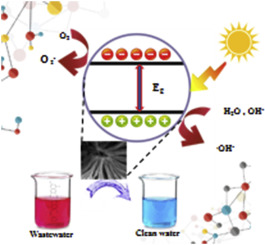当前位置:
X-MOL 学术
›
Mater. Sci. Semicond. Proc.
›
论文详情
Our official English website, www.x-mol.net, welcomes your
feedback! (Note: you will need to create a separate account there.)
Design, fabrication, electro- and photoelectrochemical investigations of novel CoTiO3/CuBi2O4 heterojunction semiconductor: An efficient photocatalyst for the degradation of DR16 dye
Materials Science in Semiconductor Processing ( IF 4.2 ) Pub Date : 2020-07-01 , DOI: 10.1016/j.mssp.2020.105055 Hamed Ramezanalizadeh , Ezzat Rafiee
Materials Science in Semiconductor Processing ( IF 4.2 ) Pub Date : 2020-07-01 , DOI: 10.1016/j.mssp.2020.105055 Hamed Ramezanalizadeh , Ezzat Rafiee

|
Abstract In this study, design and preparation of a novel heterojunction nanocomposites based on CoTiO3 and CuBi2O4 noted as CoTiO3/CuBi2O4 is reported with the aid of a facile and eco-friendly synthesis approach. This study is the first attempt on the employing of CoTiO3/CuBi2O4 semiconductor for the photocatalytic degradation of organic dye. To confirm and address the straightforward synthesis of CoTiO3, CuBi2O4 and CoTiO3/CuBi2O4 heterojunction nanostructures different characterization techniques including XRD, DRS, FT-IR, FESEM, EDX, and ICP-OES are utilized. The BET is used to calculate the specific surface area from the N2 physisorption isotherm. The prepared CoTiO3/CuBi2O4 was used for the photocatalytic degradation of Direct Red16 dye under LED visible light irradiation. Accordingly, different experimental conditions were evaluated for the photocatalytic degradation of DR16 dye over prepared catalysts. Based on the obtained results CoTiO3/CuBi2O4 heterojunction nanocomposites in pH = 4.3 and loading of 5 g/L showed the highest removal efficiency. Hence, the superior photocatalytic performance of the CoTiO3/CuBi2O4 heterojunction is due to the efficient separation of electron-hole pairs, compatible junction formation, visible light absorption ability, suitable band gap and large amount of light harvesting. Mott-Schottky, Nyquist and Bode plots have been studied. Current in the light was higher than that in the dark indicating the efficient formation of photocurrent. According to the trapping experiments h+ was found as the main active species in the photocatalytic degradation mechanism. Moreover, the synthesized CoTiO3/CuBi2O4 heterojunction could be reused four times without noticeable loss of activity.
中文翻译:

新型 CoTiO3/CuBi2O4 异质结半导体的设计、制造、电化学和光电化学研究:一种用于降解 DR16 染料的高效光催化剂
摘要 在这项研究中,报告了一种基于 CoTiO3 和 CuBi2O4 的新型异质结纳米复合材料(称为 CoTiO3/CuBi2O4)的设计和制备,并采用了一种简便且环保的合成方法。本研究是首次尝试使用 CoTiO3/CuBi2O4 半导体光催化降解有机染料。为了确认和解决 CoTiO3、CuBi2O4 和 CoTiO3/CuBi2O4 异质结纳米结构的直接合成,使用了不同的表征技术,包括 XRD、DRS、FT-IR、FESEM、EDX 和 ICP-OES。BET 用于根据 N2 物理吸附等温线计算比表面积。制备的 CoTiO3/CuBi2O4 用于 LED 可见光照射下 Direct Red16 染料的光催化降解。因此,在不同的实验条件下评估了 DR16 染料在制备的催化剂上的光催化降解。根据获得的结果,CoTiO3/CuBi2O4 异质结纳米复合材料在 pH = 4.3 和负载量为 5 g/L 时表现出最高的去除效率。因此,CoTiO3/CuBi2O4异质结优异的光催化性能归功于电子-空穴对的有效分离、相容的结形成、可见光吸收能力、合适的带隙和大量的光收集。已经研究了 Mott-Schottky、Nyquist 和 Bode 图。光下的电流高于黑暗中的电流,表明光电流的有效形成。根据捕获实验,发现 h+ 是光催化降解机制中的主要活性物质。而且,
更新日期:2020-07-01
中文翻译:

新型 CoTiO3/CuBi2O4 异质结半导体的设计、制造、电化学和光电化学研究:一种用于降解 DR16 染料的高效光催化剂
摘要 在这项研究中,报告了一种基于 CoTiO3 和 CuBi2O4 的新型异质结纳米复合材料(称为 CoTiO3/CuBi2O4)的设计和制备,并采用了一种简便且环保的合成方法。本研究是首次尝试使用 CoTiO3/CuBi2O4 半导体光催化降解有机染料。为了确认和解决 CoTiO3、CuBi2O4 和 CoTiO3/CuBi2O4 异质结纳米结构的直接合成,使用了不同的表征技术,包括 XRD、DRS、FT-IR、FESEM、EDX 和 ICP-OES。BET 用于根据 N2 物理吸附等温线计算比表面积。制备的 CoTiO3/CuBi2O4 用于 LED 可见光照射下 Direct Red16 染料的光催化降解。因此,在不同的实验条件下评估了 DR16 染料在制备的催化剂上的光催化降解。根据获得的结果,CoTiO3/CuBi2O4 异质结纳米复合材料在 pH = 4.3 和负载量为 5 g/L 时表现出最高的去除效率。因此,CoTiO3/CuBi2O4异质结优异的光催化性能归功于电子-空穴对的有效分离、相容的结形成、可见光吸收能力、合适的带隙和大量的光收集。已经研究了 Mott-Schottky、Nyquist 和 Bode 图。光下的电流高于黑暗中的电流,表明光电流的有效形成。根据捕获实验,发现 h+ 是光催化降解机制中的主要活性物质。而且,











































 京公网安备 11010802027423号
京公网安备 11010802027423号